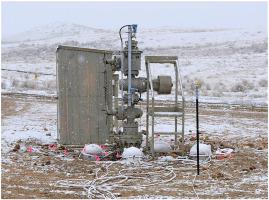Atmospheric Pollution Research ( IF 3.9 ) Pub Date : 2020-05-23 , DOI: 10.1016/j.apr.2020.05.011 Seth N. Lyman , Huy N.Q. Tran , Marc L. Mansfield , Ric Bowers , Ann Smith

|
We measured methane and carbon dioxide fluxes at natural gas well pad soils and undisturbed soils in the Rocky Mountain and Gulf Coast regions of the United States, including producing and gas storage wells. We collected both short-term (15 min) and multi-day (between 3 and 8), continuous measurements at 47 well pads and two undisturbed locations. Methane fluxes varied by more than an order of magnitude over periods as short as 30 min (e.g., 19–593 mg m−2 h−1 in one instance), and diurnal and seasonal variability was also significant (e.g., spring-to-fall change from 509 to 14174 mg m−2 h−1). We hypothesize that short-term flux variability was caused by pulsed flow of methane during its migration through the subsurface. Barometric pressure and well conditions likely impacted fluxes, but we found only weak evidence for this. Bacterial methanotrophy appeared to impact methane flux magnitude and variability. We injected methane into the subsurface at one well, and we found that, while fluxes of methane and carbon dioxide, and combustible soil gas concentrations, increased in response to the injection, the response was not uniform, and fluxes exhibited high hourly-scale variability, in spite of a constant injection rate. Methane fluxes tended to be higher at well pad soils compared to background soils (often much higher), and fluxes tended to be higher at well pad locations closer to the well head.
中文翻译:

天然气井垫层土壤甲烷通量的强烈时间变化
我们测量了美国落基山和墨西哥湾沿岸地区(包括生产和储气井)的天然气井垫土和未扰动土的甲烷和二氧化碳通量。我们收集了短期(15分钟)和多日(3到8之间)的连续数据,分别在47个井垫和两个不受干扰的位置进行了测量。在短至30分钟的时间内,甲烷通量变化幅度大于一个数量级(例如,一次为19–593 mg m -2 h -1),并且昼夜和季节变化也很明显(例如,春季至春季)。下降变化从509到14174 mg m -2 h -1)。我们假设短期通量变化是由甲烷在地下移动过程中的脉冲流引起的。大气压力和井况可能会影响通量,但我们仅发现了微弱的证据。细菌甲烷营养似乎影响甲烷通量的大小和变异性。我们在一口井中将甲烷注入地下,我们发现,尽管甲烷和二氧化碳的通量以及可燃性土壤气体的浓度随着注入而增加,但响应并不均匀,并且通量表现出较高的时标变化性,尽管注入速度恒定。与背景土壤相比,井垫土壤中的甲烷通量往往更高(通常更高),并且在靠近井口的井垫位置中甲烷通量往往更高。











































 京公网安备 11010802027423号
京公网安备 11010802027423号